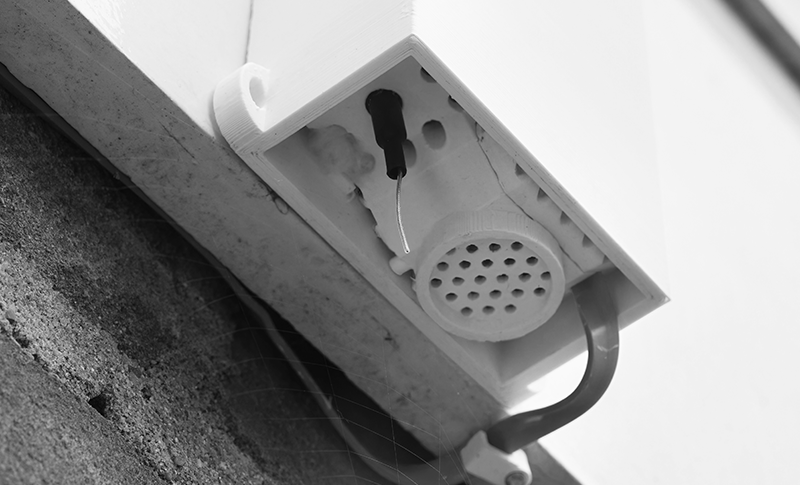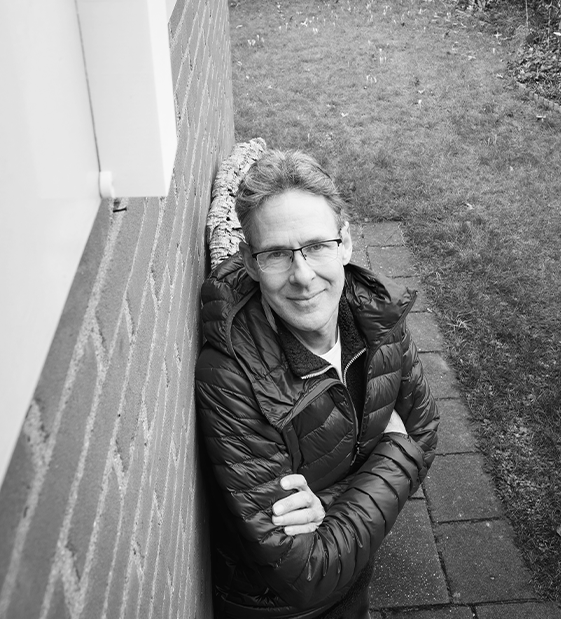Burning wood wrecks air quality. But how do you prove that? Thanks to meteorologist Bert Heusinkveld, Wageningen now has the best measuring network for fine particulate matter in the world.
Log fires and wood-burning stoves are so cosy. They give us a kind of primal feeling. Civilization began with the discovery of fire, but that cosy feeling comes at a price. Burning wood pollutes the air with nitrogen oxides, soot and fine particles. And in no small quantities. According to research by the National Institute for Public Health and the Environment (RIVM), wood-burning stoves in the Netherlands emit more particulate matter than all the traffic combined.
If your neighbours’ wood-burning stove or log fire affects your health, there’s not much you can do about it. Burning wood is allowed, and data is scarce on the pollution it causes. But that’s about to change in Wageningen. The Wageningen Air Quality Monitoring Network, set up in recent weeks, measures the particulate matter in the air at the neighbourhood level. The man behind this citizen science project is WUR meteorologist Bert Heusinkveld. He designed a new device specially for it: the Heusinkveld sensor. ‘The best citizen science sensor in the world,’ in his own words.
Do-it-yourself
Heusinkveld got involved in the wood-burning issue through Platform Duurzaam Wageningen (Sustainability Platform Wageningen), who invited him to give a talk in the library last autumn on the city’s air quality. ‘I expressed my wish then to start a citizens’ measurement network. It turned out that Duurzaam Wageningen wanted the same thing. We wondered whether it was possible to measure air quality with a simple sensor?’ There are such sensors, but the problem is that they are not very good, says Heusinkveld. They are definitely not up to demonstrating the pollution caused by burning wood. ‘People burn wood when it’s cold, and that is often when it’s foggy too. The existing sensors stop working well at a humidity level of 70 per cent. So that’s no good to you. I wanted a good sensor with which you can go on measuring even at high humidity levels.’
So Heusinkveld started tinkering himself – although ‘tinkering’ doesn’t do justice to the device he designed. The instrument is a state-of-the-art piece of measuring equipment, packaged in a 3D-printed, durable and weatherproof box. It has to be hung up outdoors near the house ‑ the power cable is three metres long. A small antenna transmits the data via the home’s Wi-Fi network. Thanks to a municipal grant of 2500 euros, the device costs the 70 participants in the citizens’ measurement network only 30 euros. Heusinkveld is rather amazed by the great interest in his project. ‘I was quite blown away by it. This gives us the densest network in the world in one fell swoop. And there is even a waiting list.’
The most innovative aspect of the design is that the device goes on working even at high humidity levels. The solution Heusinkveld came up with is simple: heat the air. ‘Condensation forms on the particulate matter and that makes the sensor go on the blink. If you heat the air, the water evaporates. The heat is given off by the electronics that read the sensor. I estimate that I can still get measurements at up to nearly 100 per cent humidity with this. So you gain a lot of measuring capacity.’ Another big plus is the measurement range. The sensor not only measures particulate matter in densities of PM10, PM4 and PM2.5, but also PM1. PM stands for particulate matter, or the mass density of fine particles. The number indicates the maximum size in micrometres. The PM1 density level is significant, as it penetrates the lungs the deepest. Heusinkveld: ‘The coarser particles don’t get beyond the nose and throat. But particulate matter of one to five micrometres penetrates deep into the lungs. And below PM1 it really enters the alveoli. Soot particles are so small that we can’t even measure them with this sensor. That’s on the scale of ultrafine dust.’

Sneaky
Heusinkveld knows what it means to be affected by particulate matter. ‘I also have a personal drive to do this work. As a child, I suffered from asthmatic bronchitis. I don’t anymore. But I have experienced it as an adult when, after a cosy evening around a log fire, I coughed and spluttered all night long. I had inhaled smoke. Air quality standards are often about average values that mustn’t be exceeded. But that ignores the peaks to which people are exposed.’
Actually, there are no safe values when it comes to particulate matter, says Heusinkveld. People who are sensitive to smoke are often told not to go outdoors on days when woodfires are in use. But that completely ignores the fact that wood smoke is harmful to everyone, even if you don’t have a cough or other symptoms. It sneaks up on you surreptitiously.’
Heusinkveld’s meter measures particulate matter accurately. But how do you establish a link with wood burning? Heusinkveld: ‘The device also measures the level of volatile organic hydrocarbons and nitrogen oxides in the air. Not precisely, but it does give you a rough idea.
Fine particles of one to five micrometres penetrate deep into the lungs
Combining these measurements helps you estimate whether the particulate matter comes from wood burning or from traffic. You can also tell by the shape of the signal itself. My sensor gives a signal every 145 seconds. Wood burning doesn’t produce a nice, smooth line, but a spiky signal; each passing puff of smoke creates a spike.’
Substantiating complaints
The measurement network enables Heusinkveld (and everyone else, see inset on the Sensor Community) to get a detailed picture of the air quality in Wageningen. ‘So you can tell from the data which are the clean neighbourhoods and which are the dirty ones, where there are sources of particulate matter and where there are none. I will soon be able to see from the multi-year data whether the widening of the Nijenoord Allee has an impact. And do those wood-burning stoves make the pollution worse? Of course, I don’t know which households have wood-burning stoves. I can’t see through the front door. But with enough observations, theoretically you could even locate a source.’
There are more than a million wood-burning stoves and fireplaces in the Netherlands. Most of them are only lit occasionally, for the ambiance they create. But energy bills are changing that. ‘With today’s high gas prices, you can’t blame people for looking for alternatives for heating their homes,’ says Heusinkveld. ‘But that should not happen at the expense of air quality and therefore of people’s health. For traffic, we have long since taken measures to reduce pollution. Cars have catalytic converters and particulate filters and there is lead-free petrol. But with stoves, anything goes. New wood-burning stoves do have to comply with the EcoDesign seal of approval. But that label only sets standards for efficiency and carbon monoxide emissions. It says nothing about particulate matter. The RIVM issues alerts on wood-burning, but they are non-binding. Meanwhile, complaints are pouring in about health problems caused by wood-burning. Following one such complaint, the Council of State recently ordered a municipality to carry out further research. With measurements like ours, you can substantiate a complaint like that, especially on damp nights, when previously nothing could be measured. Once you have figures, you can motivate municipalities to take action.’
Sensor Community
The data from the Wageningen measurement network are published on the Sensor Community website, a global platform for environmental measurements by citizens. RIVM uses the Dutch measurements for its own project Samen Meten (Measuring Together). WUR will install three meters of its own: two on campus and one at the Veenkampen measuring station in the Binnenveld. The neighbourhood with the most wood-burning stoves is Sahara on Wageningse Berg, where there are lots of detached houses. The area with the fewest wood-burning stoves is the Nude, a neighbourhood with many flats without the space for a stove. The Wageningen monitoring network is a joint initiative of WUR, Platform Duurzaam Wageningen, Stadslab and the municipality of Wageningen.

 Photo’s Guy Ackermans
Photo’s Guy Ackermans 

![[The Proposition] ‘Environmental science enables a healthy environment in a nonstop polluting society’](https://www.resource-online.nl/app/uploads/2024/05/WEB_de-stelling.png)